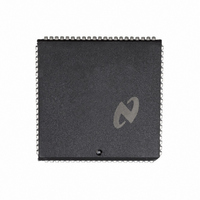DP8344BV National Semiconductor, DP8344BV Datasheet - Page 8

DP8344BV
Manufacturer Part Number
DP8344BV
Description
IC BIPHASE COMM PROCESSR 84-PLCC
Manufacturer
National Semiconductor
Datasheet
1.DP8344BV.pdf
(184 pages)
Specifications of DP8344BV
Processor Type
8-Bit RISC
Speed
20MHz
Voltage
4.5 ~ 5.5V
Mounting Type
Surface Mount
Package / Case
84-PLCC
Operating Supply Voltage (typ)
5V
Operating Supply Voltage (max)
5.5V
Operating Supply Voltage (min)
4.5V
Mounting
Surface Mount
Operating Temperature (max)
70C
Operating Temperature (min)
0C
Operating Temperature Classification
Commercial
Lead Free Status / RoHS Status
Contains lead / RoHS non-compliant
Features
-
Lead Free Status / Rohs Status
Not Compliant
Other names
*DP8344BV
Available stocks
Company
Part Number
Manufacturer
Quantity
Price
Company:
Part Number:
DP8344BV
Manufacturer:
NSC
Quantity:
5 510
Part Number:
DP8344BV
Manufacturer:
NS/国半
Quantity:
20 000
1 0 Communications Processor Introduction
The increased demand for computer connectivity has driven
National Semiconductor to develop the next generation of
special purpose microprocessors The DP8344B is the first
example of a ‘‘Communications Processor’’ for the IBM en-
vironment It integrates a very fast full function microproc-
essor with highly specialized transceiver circuitry The com-
bination of speed power and features allows the designer
to easily implement a state-of-the-art communications inter-
face Typical applications for a communications processor
are terminal emulation boards for PCs stand-alone termi-
nals printer interfaces and cluster controllers
The transceiver is designed to simplify the handling of spe-
cific communication protocols This feature makes it possi-
ble to quickly develop interfaces and software with little con-
cern for the ‘‘housekeeping’’ details of the protocol being
used
1 1 COMMUNICATIONS PROTOCOLS
A communication protocol is a set of rules which defines the
physical electrical and software specifications required to
successfully transfer data between two systems
The physical specification includes the network architec-
ture as well as the type of connecting medium the connec-
tors used and the maximum distance between connections
Networks may be configured in ‘‘loops ’’ ‘‘stars ’’ or ‘‘daisy
chains ’’ and they often use standard coaxial or twisted-pair
cable
The electrical specification includes the polarity and ampli-
tude of the signal the frequency (bit rate) and encoding
technique One common method of encoding is called ‘‘bi-
phase’’ or ‘‘Manchester II ’’ This technique combines the
clock and data information into one transmission by encod-
ing data as a ‘‘mid-bit’’ transition Figure 1-1 shows how the
data transition is related to the bit boundary in a typical
transmission The polarity of the ‘‘mid-bit’’ transition en-
FIGURE 1-2 IBM 3270 Message Format
FIGURE 1-1 Biphase Encoding
8
1-2 The transmission begins with a very specific start se-
codes the data value other transitions lie on bit boundaries
Bit boundaries are not always indicated by transitions so
techniques employing start sequences and sync bits are
used with bi-phase transmissions to ensure proper frame
alignment and synchronization
The software specification covers the use of start se-
quences and sync bits as well as defining the message
format Parity bits may be used to ensure data integrity The
message format is the ‘‘language’’ that is used to exchange
information across the connecting medium It defines com-
mand and control words response times and expected re-
sponses
The DP8344B Bi-phase Communications Processor sup-
ports both the IBM 3270 and 5250 communication proto-
cols as well as IBM 3299 and a general purpose 8-bit proto-
col The specialized transceiver is combined with a micro-
processor whose instruction set is optimized for use in a
communications environment This makes the DP8344 a
powerful single-chip solution to a wide range of communica-
tion applications
An example of an IBM 3270 message is shown in Figure
quence and sync pulse for synchronization This is followed
by the data command and parity bits Finally the end se-
quence defines the end of the transmission
The IBM 3270 and 5250 are two widely used protocols The
3270 protocol was developed for the 370 class mainframe
and it employs coaxial cable in a ‘‘star’’ configuration The
5250 protocol was developed for the System 3x machines
and it uses a ‘‘daisy-chain’’ of twin-ax cable A good over-
view of both of these environments may be found in the
‘‘Multi-Protocol Adapter System User Guide’’ from National
Semiconductor and in the Transceiver section of this docu-
ment
TL F 9336– B7
TL F 9336– B8












